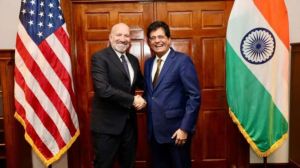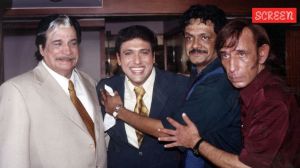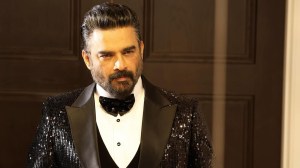In fast-track city, old-world Khurana runs a solitary race
If elections are won on favours and pavement-thumping activism, then the BJP’s candidate for chief minister of Delhi, Madan Lal Khurana...

If elections are won on favours and pavement-thumping activism, then the BJP’s candidate for chief minister of Delhi, Madan Lal Khurana, should be well ahead of his rival, Congress Chief Minister Sheila Dikshit.
From kirana merchants to transporters, from illegal factory owners to house owners in unauthorised colonies and those tapping power from overhead lines, the indefatigable Khurana has moved heaven and earth to push their claims, no matter how illegitimate their demands.
Khurana is an unabashedly old-school politician, who has over several decades accumulated a huge bank of IOUs. Whether it is a job application or municipal clearance for an unauthorised basement, Khurana is always willing to provide a helping hand. ‘‘Whenever we have a problem with the authorities, we know we can turn to Khurana for help,’’ says grocer Deepak Jain, a die-hard BJP supporter.
At 67, Khurana is still eager to grab every photo opportunity, participate enthusiastically in rallies and demonstrations screaming himself hoarse on emotive issues such as cow slaughter and the influx of illegal Bangladeshi migrants.
And yet, poll surveys indicate that Dikshit enjoys a clear edge over Khurana in the race for control of the Delhi Assembly. And this despite the chief minister’s obvious handicaps. Unlike Khurana, a Punjabi refugee who worked his way up the political ladder, 65-year-old Dikshit was an outsider foisted by Sonia Gandhi on the party’s reluctant local heavyweights from Jagdish Tytler to Sajjan Kumar. The convent-educated daughter of a senior Army officer married to a civil servant from a prominent political family was a political novice and a lacklustre orator. The white-haired auntyji seemed out of her depth in the quagmire of party and city politics.
Dikshit’s USP is the general impression that things are looking up in Delhi. And this feel-good factor cuts across the caste, class and social divide. Deepak Arora, a student, marvels at the improvement of the quality of the air in what was once India’s most polluted city thanks to the switch from diesel to CNG buses. His companion Gaurav Sabharwal is impressed by the swanky new Metro line and the network of smart, spaghetti flyovers which have sprung up at regular intervals along the ring roads, drastically cutting down the time the average Delhite spends on the road.
Kailash, a housewife in Bara Pulia, concedes that Delhi’s erratic power supply has taken a turn for the better ever since power distribution and billing was handed over to private companies, which has also made billing more efficient and transparent. Striking a negative note in the chorus of approval is Shiv Pal, an autorickshaw driver, who grumbles that the government has made his life miserable with the insistance on CNG for his autorickshaw.
Dikshit is conscious of her trump card and her posters and campaign literature hammer home the theme, ‘‘Vote for performance. Join hands with progress.’’ Her critics might quibble that it is a moot point whether Dikshit can take credit of the many visible improvements in the Capital. It was the Supreme Court which forced the hand of a reluctant Delhi government to replace all diesel-run public buses with vehicles using environmentally friendly fuel. The mammoth Metro project and many of the flyovers are joint ventures between the local government and the Centre. Delhi is not a state and key departments such as the police and the Delhi Development Authority continue to be under the control of the Central Government.
But Dikshit was smart enough to grab the credit for Delhi’s development, whereas Khurana, living in a time warp, has yet to outgrow a lifetime’s habit of opposing change and any scheme taken up by the rival party. He even advocated Sky Bus rather than a Metro. Khurana was far more vocal than Dikshit in opposing the court’s CNG order and predicting dire consequences. He subverted another court order calling for the relocating of polluting industries outside the city limits, assuming that he would earn the gratitude of the 70,000 industrial workers whose workplaces were being shifted. He clashed with his own party’s Urban Affairs Minister Jagmohan over the latter’s insistence on rigidly adhering to Delhi’s Master Plan. Instead, Khurana persuaded the Centre to drastically alter the Master Plan by regularising thousands of unauthorised constructions and amending building bye-laws. In Khurana’s narrow vision, the short-term benefits of appeasing affected sections outweighed the long-term damage to the city.
Khurana has an enviable record of winning 11 elections and losing only once. But his tried-and-tested formula for capturing votes might be losing its punch. Increasingly, Delhi residents are concerned more about providing good governance to the city as a whole rather than sops for different sections. This was not always the case. The conventional political wisdom was that Delhi voted alternatively for the Congress and the BJP. The voters did not objectively assess the performance of the previous governments, which is why neither the development-oriented Jana Sangh regime of the late Sixties or the Congress slogan of giving a government which works in the Eighties cut much ice with the voters. But the phenomenon of reflex anti-incumbency voting appears to be finally ending. People would prefer to objectively access performance rather than be swayed simply by populist slogans.
Alka Lamba, Khurana’s young Congress opponent in his Moti Nagar bastion, has perhaps summed up the changed mood of city in her campaign slogan, ‘‘Chodo kal ki batein.’’





- 01
- 02
- 03
- 04
- 05


























